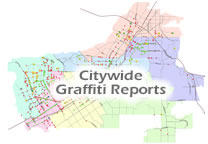Graffiti

Graffiti Vandalism in Riverside
 |
The TBTW Poster and Video Contests are now CLOSED!Thank you to all students who entered the contests this year! Please check back in April for contest results. |
Take Back the Wall
The City of Riverside spends more than $1.3 million each year for Graffiti abatement. In addition, money is spent by other public agencies, utility companies, and private property owners to remove graffiti from their properties.
Nationwide, the American public spends nearly $12 billion each year to fight graffiti.
What is Graffiti?
Graffiti consists of inscriptions, slogans and drawings scratched, scribbled or painted on a wall or other public or private surface.
Today, graffiti is a sign of urban decay. James Q. Wilson, Shattuck Professor of Government at Harvard University and author of “Thinking About Crime,” together with George L. Kelling, a research fellow at the John F. Kennedy School of Government Harvard, first introduced the world to the Broken Window Theory.
The theory contends that if a broken window is left unfixed it can quickly encourage more crime and vandalism to the neighborhood because it sends a message of indifference to observers. Graffiti is one element of the broken window theory. Once graffiti shows up somewhere, if left untreated, generally more graffiti follows.
Graffiti has become everyone’s eyesore and everyone’s problem. It generates fear of neighborhood crime and instability. It is costly, destructive, lowers property values and sends a message that people of the community are not concerned about the appearance of their neighborhood. It is against the law, and in cases where the cost of clean-up equates to $400 or more, is punishable as a felony. Graffiti is not art; it is vandalism and criminal.
Liability
Parents may be liable for up to $25,000 for each graffiti incident pursuant to Civil Code 1714.1.







